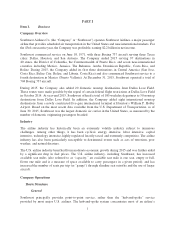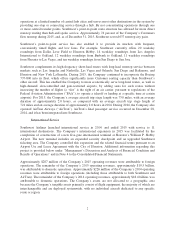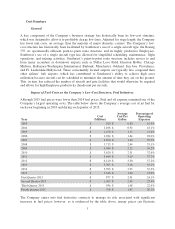Southwest Airlines 2015 Annual Report Download - page 19
Download and view the complete annual report
Please find page 19 of the 2015 Southwest Airlines annual report below. You can navigate through the pages in the report by either clicking on the pages listed below, or by using the keyword search tool below to find specific information within the annual report.services to passengers; (iv) a potential DOT proposed rule to enhance accessibility for disabled
passengers with respect to aircraft lavatories and in-flight entertainment; and (v) a potential DOT
proposed rule to restrict passenger cell phone voice calls on aircraft.
Aviation Taxes and Fees
The statutory authority for the federal government to collect most types of aviation taxes, which are
used, in part, to finance programs administered by the FAA, must be periodically reauthorized by the
U.S. Congress. In 2012, Congress adopted the FAA Modernization and Reform Act of 2012, which
extended most commercial aviation taxes through September 30, 2015. In September 2015, Congress
extended the expiration date for an additional six months. Congress is expected to try to enact a new
FAA reauthorization bill in 2016, which may make substantive changes with respect to aviation taxes
(including, possibly, airport-assessed passenger facility charges) and/or FAA offices and programs that
are financed through aviation tax revenue. Congress must either adopt a new FAA reauthorization bill
or pass a “status quo” extension by April 1, 2016; otherwise, a lapse in the statutory authority could
affect the airlines’ and passengers’ respective tax burdens, as well as impact the FAA’s ability to fund
airport grants and regulate the airline industry.
In addition to FAA-related taxes, there are additional federal taxes related to the Department of
Homeland Security. These taxes do not need to be reauthorized periodically. Congress has set the
Transportation Security Fee paid by passengers at $5.60 per one-way passenger trip. In December
2015, Congress enacted another statute that indexes immigration and customs fees to inflation,
beginning in 2016. These two fees are paid by inbound international passengers and are used to support
the operations of U.S. Customs and Border Protection (“CBP”). Finally, the U.S. Department of
Agriculture’s Animal and Plant Health Inspection Service published a final regulation in October 2015
that modifies international agriculture inspection fees. Under this new rule, effective December 28,
2015, the per-passenger agriculture inspection fee is $5.00 and the per-commercial aircraft fee is
$225.00.
In 2016, in addition to FAA reauthorization legislation, Congress may consider comprehensive tax
reform legislation, which could result in a lower corporate tax rate and the elimination of certain tax
deductions and preferences. Grants to airports and/or airport bond financing may also be affected
through future legislation, which could result in higher fees, rates, and charges at many of the airports
the Company serves.
Operational, Safety, and Health Regulation
The FAA has the authority to regulate safety aspects of civil aviation operations. Specifically, the
Company and its third-party service providers are subject to the jurisdiction of the FAA with respect to
aircraft maintenance and operations, including equipment, ground facilities, dispatch, communications,
flight training personnel, and other matters affecting air safety. The FAA, acting through its own
powers or through the appropriate U.S. Attorney, has the power to bring proceedings for the imposition
and collection of fines for violation of the FAA regulations.
To address compliance with its regulations, the FAA requires airlines to obtain the Air Carrier
Operating Certificate and other certificates, approvals, and authorities. These certificates, approvals,
and authorities are subject to suspension or revocation for cause.
The FAA has rules in effect with respect to flight, duty, and rest regulations. Among other things, the
rules require a ten hour minimum rest period prior to a pilot’s flight duty period; mandate that a pilot
11
























